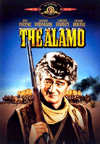The Alamo (1960)
MGM Home Entertainment
Cast: John Wayne, Richard Widmark, Laurence Harvey, Richard Boone, Linda Cristal
Extras: Documentary, Theatrical Trailer
Rating:
Even by today’s cynical standards, no one could compete with the star power of John Wayne. He truly was bigger than life. He was "the Duke." ("Repo Man" notwithstanding; those who’ve seen it will get the joke.) He stood out effortlessly among giants and when he decided to step behind the camera, his choice of subject was equally gargantuan. Just as Orson Wells grappled with William Randolph Hearst to forge "Citizen Kane, " John Wayne wrestled with another American icon for his directorial debut. An epic retelling of a sad but heroic chapter in American history, 1960’s "The Alamo" cost $12 million (back when steak dinners averaged a buck) and a decade-long effort on Mr. Wayne’s part to get it made. MGM Home Entertainment’s new DVD release now breathes new life into the forty-year-old film with a first-rate transfer, a remastered soundtrack and a smattering of extras.
Everyone should know the story of the Alamo and its tragic last days in 1836 when a ragtag army of 185 frontiersmen tried to hold the small adobe mission against the advance of 7,000 seasoned soldiers. At parts a history lesson, a paean to American heroism and a tribute to the vistas of director John Ford, "The Alamo" balances the interpersonal stories of not only historical figures but the everyday people who find themselves caught in the whirlwind of rebellion. The impressive cast, including Richard Widmark as Jim Bowie, Laurence Harvey as Col. William Travis and the Duke himself as Davy Crockett, serves James Edward Grant’s screenplay commendably, even during the soapbox speeches about liberty and honor.
Wayne as a director almost achieves the poetry of American myth that Ford could accomplish in his sleep. Scenes like the frontiersmen saying their final goodbye to their families or the men talking about religion the night before a big battle wrench with a quiet intensity. (In a truly observant moment, the embattled freedom fighters even praise their adversaries.) The film falters with an erratically paced first half and a failed romantic sub-plot involving Crockett and a lonely widow (Linda Cristal).
In its premiere engagement, the film ran 192 minutes. For the roadshow version, 30 minutes of footage was excised. While I am not familiar with the longer "director’s cut," MGM Home Entertainment released it on laserdisc a few years ago. From what I read in reviews, the longer version fleshes out the character aspects more compellingly, strengthening the pathos of their valiant mission. For whatever reasons, MGM Home Entertainment opted to preserve the 162-minute cut on DVD. As this may be the only representation of the title in the format, an opportunity to return the film intact to a mass audience may have been missed here.
"The Alamo" was filmed in 65mm Todd-AO, a process that produced ultra-sharp, finely detailed images. The 2.20 <$16x9,anamorphic> video transfer just glistens, faithfully replicating the depth of field and color that wide-gauge filmmaking was justifiably famous for. Deep black levels bring out the saturated colors with no break-up or smearing. (65mm filming required substantially greater lighting than standard 35mm photography. That’s why "The Alamo’s" nighttime scenes convey the same brilliant color rendition as the daytime scenes and exhibit no film grain.) Fleshtones are on the brownish side. Other than a few instances of speckling, the source is surprisingly clean and intact. Edge enhancement occasionally appears and some aliasing is present during the opening credits (due to the lithograph nature of the background artwork). Despite challenges like the intricate long shots containing hundreds of extras or complex color patterns in the sunsets, there are no digital or compression artifacts.
The <$DD,Dolby Digital> <$5.1,5.1 channel> soundtrack encompasses wide dynamic range, resulting in playback almost completely free of any distortion or peaks during the louder passages. Dialogue sounds natural, not at all tinny or sibilant. (While there is some attempt to replicate the "directional dialogue" prevalent of sound mixes in the ’50s and ’60s, the dialogue is firmly anchored in the center channel.) The surrounds infrequently kick in for the errant sound effect (i.e. wagons rolling over the camera POV); otherwise, the rear channels engage primarily to energize Dimitri Tiomkin’s evocative music score. Though the audio decodes as <$5.1,5.1 channel>s, the LFE is silent. A French surround track and a Spanish mono track constitute additional language options.
A forty-minute documentary providing a contemporary perspective on the making of the film and its historical inspirations is included. "John Wayne’s ’The Alamo’" mixes behind-the-scene footage, background footnotes and video interviews with cast and crewmembers for a slow but amiable look at how the film was made. The documentary even gives some juicy tidbits about how John Ford visited the set frequently to "offer guidance," frustrating Wayne to the point where he sent off Ford with a crew to shoot footage that was never intended to be used.
An original theatrical trailer accompanies the documentary. The trailer is in decent shape and presented in <$PS,widescreen>. Unfortunately, the audio distorts consistently, not at all up to par with the feature presentation.
Residing between Hollywood hokum, hero worship and involving drama, "The Alamo" never really ascends to its intended heights. We may never see the whole of John Wayne’s "The Alamo" on DVD, but the two hours and forty-two minutes we now have makes for a stirring and tantalizing primer.







